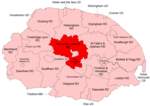Scarning Fen
Norfolk Wildlife TrustScarning

Scarning Fen is a 4-hectare (9.9-acre) nature reserve west in Dereham in Norfolk. It is managed by the Norfolk Wildlife Trust. It is a Nature Conservation Review site, Grade I, and is part of Potter and Scarning Fens Site of Special Scientific Interest and Norfolk Valley Fens Special Area of Conservation.This small reserve has chalky valley mire, carr and grassland. Twenty-nine nationally scarce invertebrates have been recorded, and it is the only site in the county for the small red damselfly. There are a number of rare plants, including liverworts and mosses.
Excerpt from the Wikipedia article Scarning Fen (License: CC BY-SA 3.0, Authors, Images).Scarning Fen
Fen Road, Breckland District
Geographical coordinates (GPS) Address Nearby Places Show on map
Geographical coordinates (GPS)
| Latitude | Longitude |
|---|---|
| N 52.67 ° | E 0.928 ° |
Address
Fen Road
Fen Road
NR19 1LN Breckland District
England, United Kingdom
Open on Google Maps








